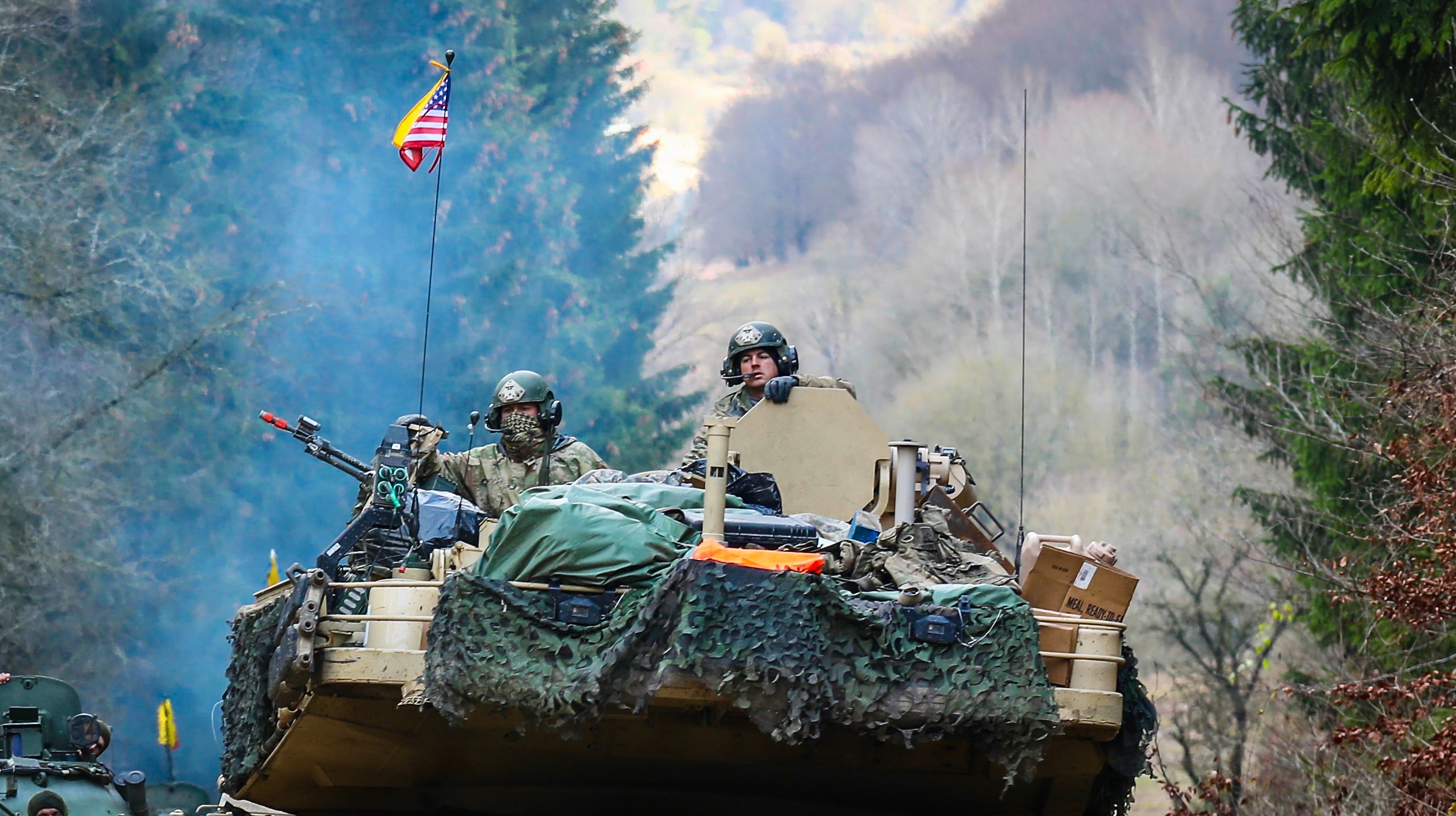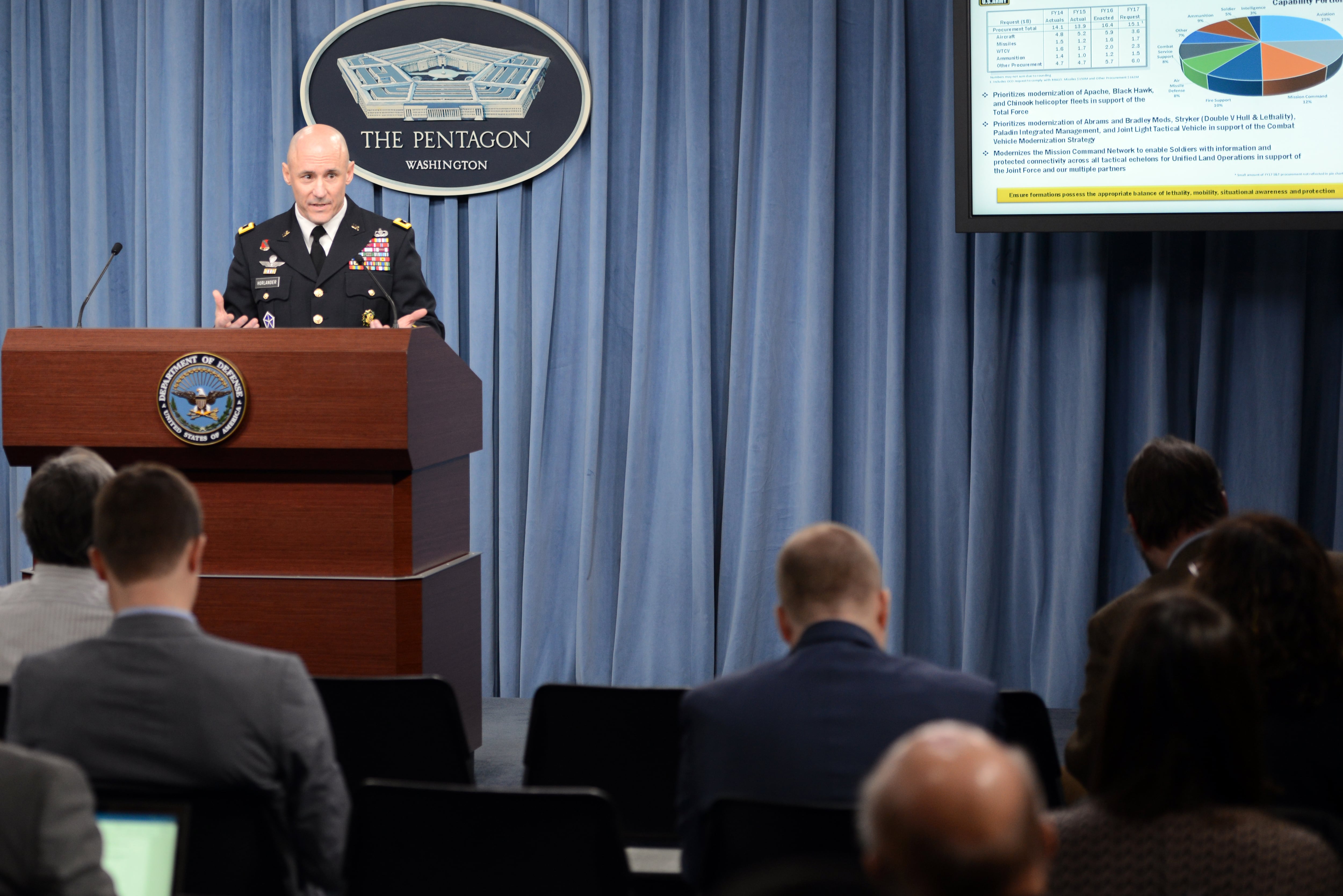WASHINGTON — The U.S. Army’s budget request of $178 billion for fiscal 2021 represents a “slight" reduction in funding over last year’s budget request of $182 billion, according to documents release Feb. 10 that outline the service’s budget request. However, the Army is still prioritizing its personnel, readiness and modernization through efforts to realign funding and find savings.
The Army’s base budget request is $150.3 billion, which is $700 million shy of its FY19 and FY20 request, so the service would mostly see a several billion dollar decrease in funding in its overseas contingency operations account when compared to last year’s request if enacted by Congress.
The service is asking for $24.9 billion in OCO funding, which is money allocated for war operations overseas, as well as $2.8 billion in OCO-for-base funding. It asked for a total of $31.4 billion in FY20 across both of those accounts.
OCO-for-base funding is money that could be in the base budget, but is classified as OCO for the purpose of getting around statutory budget caps imposed by Congress. Both Congress and the Pentagon have previously relied on OCO as a workaround for the budget caps.
RELATED

The budget request in FY20 was geared toward jump-starting a modernization renaissance the service began in 2018 with the establishment of its newest four-star command — Army Futures Command — which is dedicated to building a modern force by 2028.
The FY21 budget continues down the path to rapidly procuring new capabilities across the force, from building new aircraft and vehicles to modernizing the service’s network and missile defense architecture as well as increasing soldier lethality. The budget also injects funding into the Army chief’s top priority — people.
The request also aims to support a joint force that can operate across all domains — land, sea, air, space and cyberspace — and it builds the service’s strategic readiness while sustaining tactical readiness, according to a budget overview.
The Army realigned $2.4 billion from “lower priority programs” in FY21 to pay for readiness and its ambitious modernization efforts, the overview stated. To shift those funds, the service eliminated 41 programs and reduced or delayed another 39 programs across the five-year budget plan from FY21 through FY25 “that were not tied to the [National Defense Strategy] or modernization priorities,” and would allow $13.5 billion in funds to be shifted, the Army’s budget documents noted.
Click here for more coverage of the FY21 budget.
Army Secretary Ryan McCarthy said in 2019 that the service aimed to find another $10 billion across the five-year plan in FY21 to apply to priority programs. He warned that harder decisions would have to come in future budget requests beyond FY21.
By comparison, the Army cut 93 programs and delayed or reduced 93 programs across the five-year budget plan in FY20.
The Army’s end strength is expected to continue growing in FY21. The service adjusted its goals in FY20 after a bad recruiting year in 2019, but has updated its FY20 end strength target by 5,000 soldiers to 485,000 in the regular component. The Army anticipates it will reach an end strength of 485,900 in the active force in FY21, after predicting in the FY20 budget request that it would only grow by 2,000 a year. According to a footnote, the Army will transfer 100 of those soldiers to the U.S. Space Force.

The Army National Guard is expected to grow by 500 in FY21 to 336,500, after not growing between FY19 and FY20. The Army Reserve is expected to grow by 300 to a total of 189,800. The Reserve component shrank by 1,219 from FY19 to FY20.
The budget supports a total Army end strength of 1,012,200 soldiers. The military personnel funding request is $62.5 billion, which is $2.8 billion more than Congress enacted in FY20.
Operations and maintenance
The operations and maintenance (O&M) account would grow by roughly $2.1 billion in the base budget for the regular component in FY21, from $41 billion enacted in FY20 to $43.1 billion in the new request. The Army is also asking for $14.3 billion in OCO for O&M, down from $19 million enacted in FY20.
Overall, the O&M budget request across all components is $2.4 billion less than the funding enacted in FY20, totaling $68 billion.
The account will fund critical strategic readiness exercises like Defender Europe and Defender Pacific as well as O&M OCO funding to support operations in Iraq and Afghanistan as well as European Deterrence Initiative efforts, which seek to support allies against an aggressive Russian military posture on the eastern flank of Europe.
The Pentagon is funding the European Deterrence Initiative at $4.5 billion, which is $1.5 billion less than enacted in FY20, but the reduction was planned as the U.S. military wraps up major infrastructure efforts in Europe related to the initiative.
The Army’s request also funds 31 brigade combat teams, five security force assistance brigades and one in the Army National Guard, and 11 combat aviation brigades.
O&M funding in FY21 will shift from a focus on the Defender Europe series already kicking off this fiscal year to the Pacific version of the exercise.
The Army is funding 24 brigade combat training-level combat training center rotations in FY21.
Research and development
The Army is seeking $36.8 billion in research development and acquisition funding that aligns with the service’s modernization priorities: long-range precision fires, next-generation combat vehicle, future vertical lift, the network, air and missile defense, and soldier lethality.
The budget request asks for $24 billion in procurement and $12.7 billion in research, development, test and evaluation funding. The Army received $37.8 billion in FY20 for research, development and acquisition.
The service also highlights three particular lines of effort in its budget documents that fall either under one of the top priorities or is being carried out through its Rapid Capabilities and Critical Technologies Office: hypersonic weapons, the Directed Energy Mobile Short-Range Air Defense System (DE-MSHORAD) and the Indirect Fire Protection Capability.
The Army plans to field the first hypersonic unit and fire test shots in FY22, and it wants to field combat rounds in FY23.
The first DE-MSHORAD will be fielded on Stryker combat vehicles “within the next year,” the budget documents stated.

The IFPC effort is meant to produce a mobile capability to defend against unmanned aircraft systems, cruise missiles, rockets, artillery and mortars. The Army has yet to lay out its full strategy for the capability.
The Army also has aligned 79 percent of its science and technology funding to move modernization priority-related concepts and capabilities more quickly in FY21.
The request also includes funding to modernize critical systems in the fleet, such as the Bradley Infantry Fighting Vehicle, the Stryker armored vehicle, the M1 Abrams tank and the Paladin howitzer.
Procurement
In its procurement account, the service is requesting $24 billion within the base budget and OCO, which is $1 billion less than Congress enacted in FY20.
The request asks for $3.5 billion in aviation procurement, including the intent to buy 36 UH-60M Black Hawk utility helicopters for a total of $830 million in FY21, as well as 50 AH-64E Apache attack helicopters for a total of $961 million.
The service is asking for $4.3 billion in missile procurement to include the first-year buy for the Long-Range Precision Munition Anti-Tank/Assault Missile System. Funding would support the production of 168 Patriot Missile Segment Enhancement missiles for $780 million and 6,288 Guided Multiple Launch Rocket Systems for $977 million.
The Army wants $3.7 million to procure weapons and tracked combat vehicles, which is $1.3 billion less than enacted in FY20.
It’s also asking to spend $847 million to exchange 154 flat-bottom hull Strykers for double V-hull vehicles. A total of 42 of those would get a 30mm gun. Funding would also equip the second of three M-SHORAD battalions.
The service plans to spend $1 billion on Abrams upgrades in FY21; it plans to upgrade 89 of the M1A1 tanks to the M1A2 version.
While the Army cut some upgrades to the Bradley last year, it is still supporting some upgrades to handle obsolescence mitigation as well as suspension, track, power train and electrical improvement.
The service also wants to spend nearly $1 billion procuring 40,219 units of its brand-new Integrated Visual Augmented System.
Reform
The Army was able to find $2.4 billion in FY21 to meet priority needs by identifying $1.4 billion that could be saved through reforms. A total of $900 million of that came from realigning resources, another $200 million from improvements made to business processes and another $300 million in divestments, according to budget documents.
The remaining $1 billion in savings not classified as reforms, according to the documents, were used to support the Army’s highest priorities.
RELATED

The service’s budget overview shows that $1.1 billion in savings came from a legacy equipment review.
Some of the ways the Army found reform opportunities and savings came from its Army Command Accountability and Execution Review Program as well as contract reviews and an FY19 audit. According to the service, the CAER Program reduced inefficient spending by 40 percent.
Jen Judson is an award-winning journalist covering land warfare for Defense News. She has also worked for Politico and Inside Defense. She holds a Master of Science degree in journalism from Boston University and a Bachelor of Arts degree from Kenyon College.








